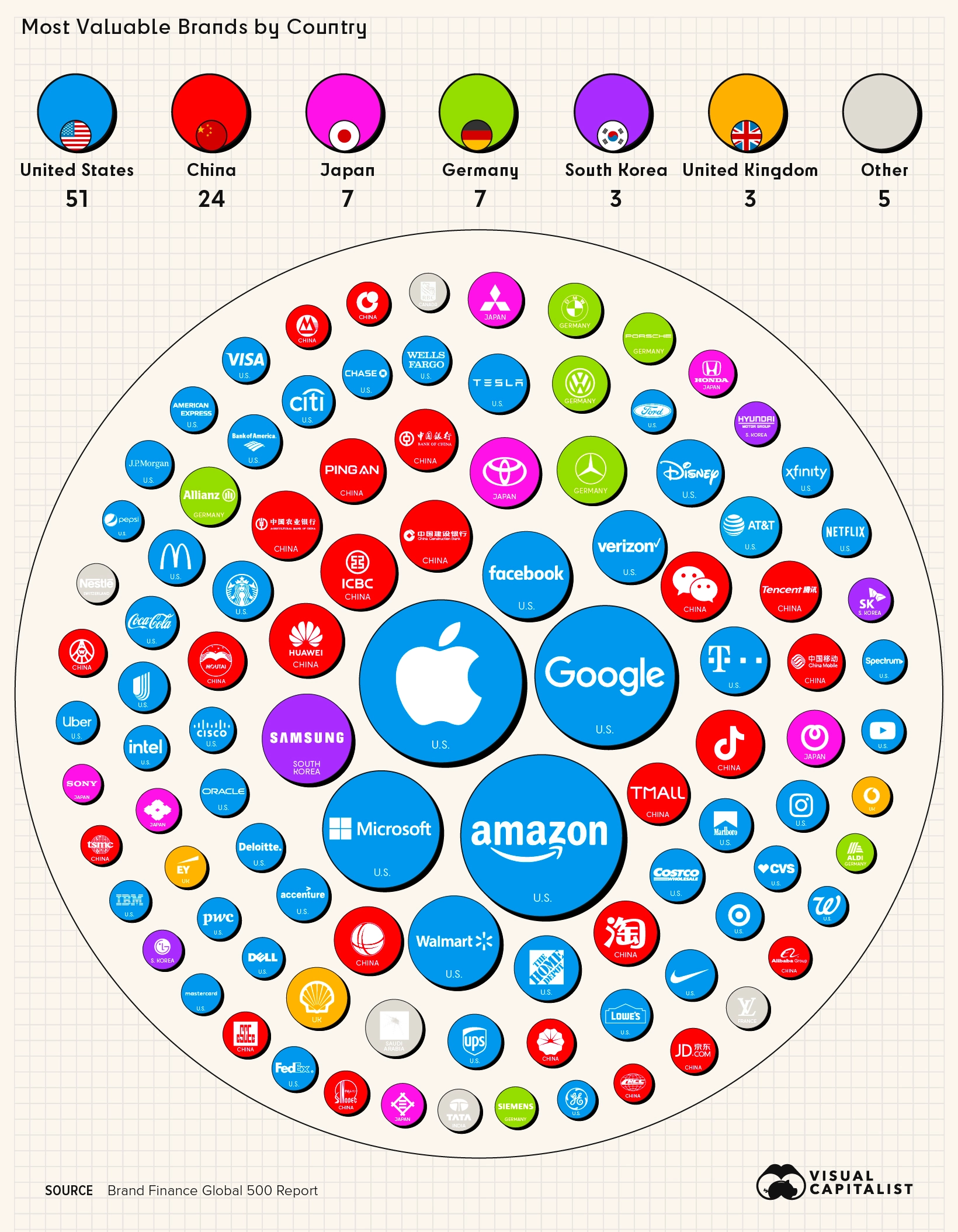The Top 100 Most Valuable Brands in 2022Published 4 days ago on October 27, 2022
By Carmen Ang
Article/Editing:
Nick Routley
Graphics/Design:
Pernia Jamshed
Tweet
Share
Share
Reddit
Email
View a higher resolution version of this graphic.
Infographic showing the most valuable brands in 2022
▼ Use This Visualization
The Top 100 Most Valuable Brands in 2022
View a higher resolution version of this graphic.
Given the allusive nature of brands, determining a brand’s financial value is a difficult task.
Despite a brand’s intangibility, it’s hard to deny just how effective a strong one can be at boosting a company’s bottom line.
With this in mind, Brand Finance takes on the challenge of identifying the world’s most valuable brands in the world in its annual Global 500 Report. The graphic above, using data from the latest edition of the report, highlights the top 100 most valuable brands in 2022.
Editor’s note: This ranking measures the value of brands, which can be thought of as marketing-related intangible assets that create a brand identity and reputation in the minds of consumers. It attempts to measure this in financial terms, calculating what the brand is worth to the company that owns it. For more information on methodology, calculations, and sourcing, go to the bottom of this article.
A Full Breakdown of the Most Valuable Brands
With an increase of 35% since last year’s report, Apple retains its top spot on the ranking as the world’s most valuable brand, with a total brand value of $335.1 billion.
This is the highest brand value ever recorded in the history of the Global 500 report, which has been published each year since 2007.
As one of the world’s largest tech companies, Apple dominates the smartphone market, especially in the U.S., where more than 50% of operating smartphones are now an iPhone.
Here’s a complete list of the 100 most valuable brands according to the report:
Search:
Rank Brand 2022 Brand Value ($B) Country Sector
1 Apple $355.1 United States Tech & Services
2 Amazon $350.3 United States Retail & Consumer Goods
3 Google $263.4 United States Media & Telecoms
4 Microsoft $184.2 United States Tech & Services
5 Walmart $111.9 United States Retail & Consumer Goods
6 Samsung Group $107.3 South Korea Tech & Services
7 Facebook $101.2 United States Media & Telecoms
8 ICBC $75.1 China Banking & Insurance
9 Huawei $71.2 China Tech & Services
10 Verizon $69.6 United States Media & Telecoms
Showing 1 to 10 of 100 entriesPreviousNext
After Apple, coming in a close second is Amazon with a brand value of $350.3 billion. This is not surprising, considering the tech giant has often found itself neck-and-neck with Apple in the rankings, and has even come in first place in previous editions of the report.
One other brand worth highlighting is TikTok. The social media company saw a 215% increase in its brand value year-over-year, making it the fastest-growing brand on the entire list.
Between 2019 and 2021, the platform saw its userbase skyrocket, growing from 291.4 million to 655.9 million in just two years. If this growth continues, TikTok could reach nearly one billion users by 2025, according to projections from Insider Intelligence.
Most Valuable Sectors
Over a third of the brands on the list fall into the tech and services sector. Combined, this category has a brand value of $2.0 trillion.
Sector Brand Value % of Top 100
Tech & Services $2.0 trillion 36.8%
Media & Telecoms $1.0 trillion 19.2%
Retail & Consumer Goods $910 billion 16.8%
Banking & Insurance $634 billion 11.7%
Energy & Utilities $411 billion 7.6%
Automobiles $400 billion 7.4%
Healthcare $33 billion 0.6%
Media is the second most valuable sector—19% of the top 100 brands fall under the media and telecoms sector, including Google, Facebook, and WeChat.
COVID-19 is partly the reason for this, as media consumption increased throughout the global pandemic. For example, in the first nine months of 2021, Snapchat’s daily usage grew by 77%. Despite increased traction with users, it’s worth noting the company is now feeling the sting as the real world competes for attention spans once again and advertisers begin to ghost the app due to recession jitters.
As pandemic restrictions fade out around the world, and murmurs of a global recession threaten global economic growth, next year’s report could see some big shifts in brand value.
The Geography of Valuable Brands
When looking at where these brands are based, we see that the United States and China account for 75 of the top 100 brands on the ranking. Even more surprising—just six countries make up 95% of the list.
The growth of Chinese companies on the global stage is reflected in this visualization. As a point of comparison, a decade ago, only six Chinese companies made Brand Finance’s Top 100 ranking, and none of them were in the top 30 for brand value.
most valuable brands by country
Interestingly, European countries only make up 13% of the list, which is a testament to just how much Europe’s economic dominance has dwindled over the last few decades.
Back in the 1960s, Europe accounted for nearly a third of the world’s total GDP. But by 2017, it had dropped down to 16%. According to a forecast by the Pardee Center of the University of Denver, the EU’s share of global GDP is expected to drop down to 10% by 2100.
Of course, if history has taught us anything, it’s that a lot can change over the span of a century. How a ranking like this will look in coming decades is anyone’s guess.
Where does this data come from?
Source: Brand Finance Global 500 Report
Important note: The values shown above are brand value calculations as opposed to market capitalization. See below for more details.
How is brand value calculated? In simple terms, the methodology for calculating “brand value” is a formula that is as follows:
Brand Strength (BSI) x Brand Royalty Rate x Brand Revenues = Brand Value
Brand Strength Index (BSI) looks at brand investment, brand equity, and brand performance. The brand royalty rate is determined based on sector. Lastly, forecast brand-specific revenues are determined based on the proportion of parent company revenues attributable to the brand in question. Brand value itself is discounted to net present value.
We recommend visiting page 94 and 99 of the report to view the full explanation of the methodology.






























